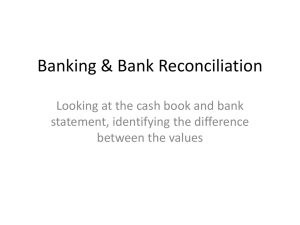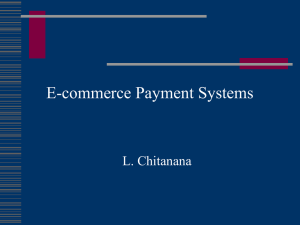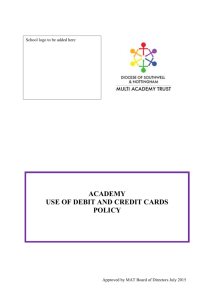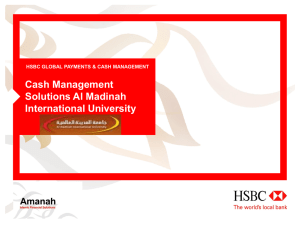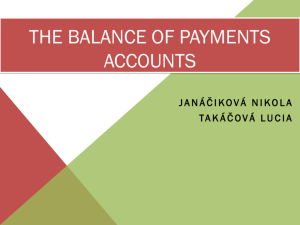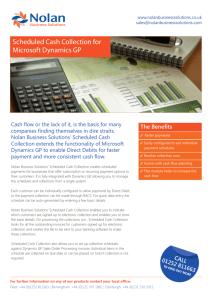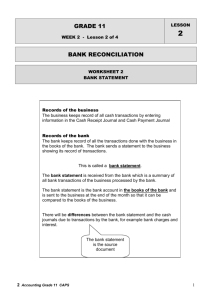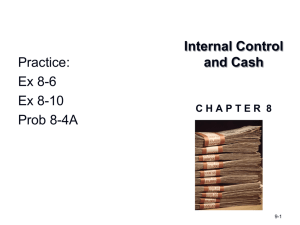Investigating methods of making and receiving payments
advertisement
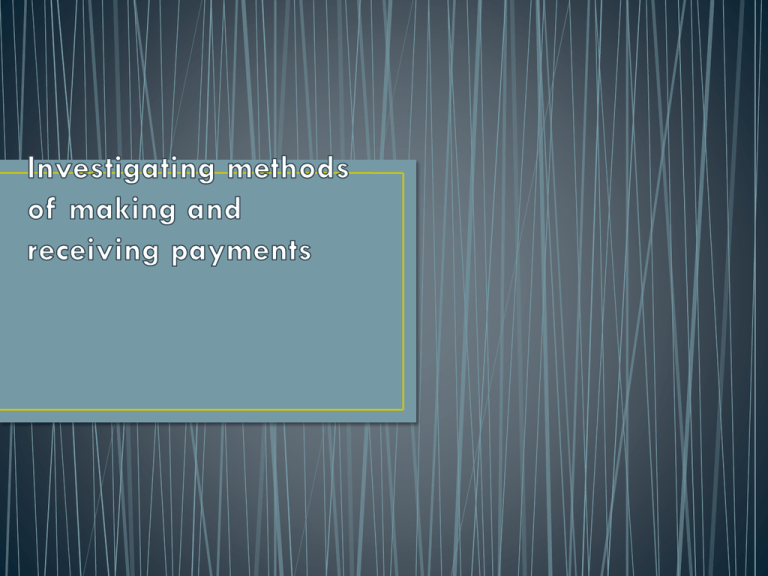
• A business makes payments for what it buys, • In return it receives payments for goods it sells or services it provides. • In the exam you will need to assess the suitability of a number of cash and non-cash payment methods, including: • •cash; • •cheque; • •credit card; • •debit card; • •credit transfer/direct debit. • You will need to understand how each payment method works, what costs are involved for the buyer and the seller, and how much time each method of payment takes. • Cash is normally used for transactions involving small amounts of money • Transaction is also a face-to-face transaction when the supplier and customer meet • A receipt is usually provided by the seller and proof that the transactions taking place in the money has been received • Money is received instantly • The risk of fraud is quite minimal • It is difficult to get hold of large amounts of money as customers (£250 from a cash machine) & customers usually have to give notice to the bank if they are going to withdraw large amounts of money • It is physically difficult to carry in store large amounts of money • There is a large security risk of carrying out transactions involving money • A cheque is a promise to pay a certain amount to a person – money is transferred from the customer’s bank to the supplier’s bank • Cheques can be used in face-to-face transactions that can also be sent through the post • Can be used payments of large amounts of money with little risk • A receipt is not needed as the transaction appears on bank statements • Cheques can be sent through the post as they can only be paid into the payee’s bank account • The cheque system is efficient and rarely goes wrong • There is a delay between writing a check on the many appealing in a payees account – the bank does not show the money is a credit until the cheque has been cleared • If cheque-book stolen then there is a chance that the thief could use it to spend money • The mistake is made on the cheque, the bank will not accept it and it will be returned • Fees are charged on business accounts and many check transactions can cause these to be implemented • When the card is used the statement is sent listing the transactions that particular month • Person involved had the option to pay off the amount in full will pay part of it and incur interest on the rest • This and therefore has a certain amount of credit for they have to pay the amount in full (usually 30 days) • Allows the holder of the credit card to purchase a product immediately and defer payment for that product • No cash is involved • The supplier receives the money within 2 to 4 days • Payment can be made over the telephone or using the Internet • Once the transaction is confirmed payment to the supplier is guaranteed • Credit card holders can use cash machines although they pay interest on the money • Interest rates can be extremely high if the cash is on paid off in full • Cash withdrawals are very expensive in terms of interest rates • Interest rates are not always transparent as the method of calculating this is quite complicated • This costly for a supplier to install and pay for an electronic terminal • There is a risk of fraud involved for the credit card companies usually bear this risk • Issued by banks in use by customers to make purchases • Many of debited automatically from a bank account • There is no interest charge and money is transferred quickly • • • • • No need for cash Transactions are quick No interest is charged Payment is guaranteed once the transaction has been validated less vulnerable to fraud as use of the card is dependent on money being present in a customer’s current account • There is a charge for processing transactions involving debit cards but this is less than for credit cards • Debit cards can be rejected if there is insufficient funds in the current account • There is a cost for the supply and install in the terminal for debit cards • This is the automatic transfer of money from one bank account to another • The system is called the Bank Automated Clearing System (BACS)which offers two main services: 1. Direct credit (credit transfer) 2. Direct debit • Money is paid from a business bank account to another bank account using electronic transfer • This is the most common way of paying wages and salaries today • The government also uses credit transfer to pay housing benefit company dividends pension payments except • Document is usually sent through the post which confirms the transfer will take place • For supplies this is the remittance advice slips • No cash is involved so there are few issues regarding security • It is a cheaper system when using cheques which businesses used in the past • Accurate records kept of the transactions that take place • Is essential to check any credit transfer payments very carefully as minor errors can cost a large company or government millions of pounds • Banks usually need some sort of advance notification that the payments are to be processed to ensure that cash is available to be paid • People increasingly pay, electricity, gas, water, telephone, insurance, etc. by direct debit • Initially a form is filled in which gives the customer’s bank account details and authorises payments to a particular business • The then sends request for payment to the customers bank on a particular day of a month throughout the year ( or whichever time period they have selected) • The business must send a notification to the customer in advance of the payment due date, stating the amount and date on which it will be collected • Customers have the right to cancel the direct debit at any time • • • • No cash involved Guaranteed payment to businesses Customers don’t have to remember to right-hand post cheques there is flexibility in the system for customers to vary the dating amount of payment • The customer receives written notification of payments • Only authorised businesses can use the system which prevents fraud • Customers may fail to check bank statements and miss increases in prices or the continuation of payment service they do not use • Customers can set up lots of direct debits and run short of cash • Standing orders a very similar to direct debits • Standing orders are made at prearranged intervals and the date and time of the amount paid cannot be varied • Standing orders are a direct arrangement between two banks and do not involve BACS
